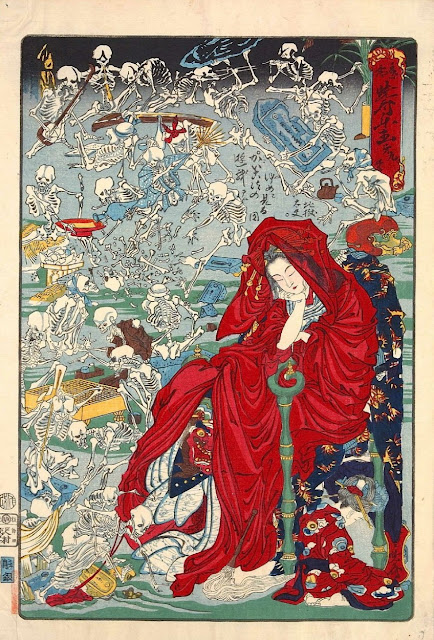The Zen rebels: obscure hermits and existential reformers (part 22). Zen myths: "The Hell Courtesan” (part 1)
("Hell Courtesan" Kawanabe Kyōsai
(1874)
Spencer Museum of Art)
When we turn our attention to the more mythical of the Zen icons, for this, it has to be drawn from the iconoclastic and rebellious Zen monk Ikkyū Sōjun, who was very much a real fixture within the Zen lineage in Japan, Ikkyū, as discussed in this series was an anti-establishment Zen monk, who, by devising in his own fraught path through the discipline of Zen Buddhism – believed that Zen, at the time in 15th Century Japan had become corrupt and watered down. To the point that it only pandered as a ceremonial jester to the Imperial courts, at the expense of the long suffering peasants and laypeople. And this is, in understating Ikkyū's motives, not just in removing the esoteric aspects of Buddhism, he was a trained Zen monk, but also showing that the suffering of hell exists without the body perishing. Religions, regardless of inclination and structure, may dismiss the true spiritualist aspect which can only be personal, yet as we know throughout history, the impression of religion has been used, in its collective implementation, to control and in most cases impoverish the poor, by using a fear of punishment in the afterlife. And this is the crucial element of Ikkyū's behavior as a rebel Zen monk, knowing that in Buddhism, from the Pure Land and Zen perspectives of hell, that, in the liberation from the Hell State is to remove the suffering and its delusions, an esoteric perspective of Buddhism shows that hell is a place after death, distinguished between the karmic cycle and the next lives. And this difference between Zen Buddhism and the more mystical aspects of Buddhist beliefs, to which the Zennist teaches that the Hell State already exists in the mind, manifested by delusions of everyday life, that suffering and its attachment to impermanence - creates the turmoil. Ikkyū, knew hell existed, he saw it; from tsunamis, wars, witnessing the peasants dying from diseases and famine. Death and destruction that seemed to be a constant affliction onto the poor and destitute. All the while the lower classes pandered to the elite for favors in hope of being graced by their presence, in their longeing for the material world.
When Ikkyū passed away in 1481 After serving his final years as the Abbot at the Daitokuji temple in Kyoto. His poetry showed a indication that even in his last years as a Zen Master, was a continued dissatisfaction and annoyance of the Zen establishment in Japan.
"This monk has passed through the narrowest mountain paths to reach the northernmost seas,
and also has the experience of crawling through the lowest valleys.
If you want to find a safe place to pass your life, Sit on the top shelf like a puppet!"
Yet, the years that followed Ikkyū's death, there began an interest in Japanese art and literature to embody some of the more mythical and fictional aspects of Zen lore, particularly the story telling. Even the fictitious and its myths, beyond what may lead to delusion, can, in most cases relay a story that holds a poignancy of direction and focus. Assisting in the explanation of reality, using metaphor and experiences to which a clever writer can weave into idealistic perspective.
One of the most revered and interesting stories that originated between the end of the Endo period of Japan (1867), which in turn embraced the modernization of Japanese culture under the renewed Meiji restoration (1868) was the “The Hell Courtesan” or Jigoku-dayū. A story set in the 16th Century Japan where we find a beautiful high end prostitute named Otoboshi dammed by her disposition of pain and sorrow, resigned in her thoughts to reign within her state of hell. Yet, she was attached to her longing to be released from the past and its trauma. Ikkyū on his travels, upon hearing her exploits of this infamous prostitute, decides to visit the legendary Hell Courtesan.
One of the most revered and interesting stories that originated between the end of the Endo period of Japan (1867), which in turn embraced the modernization of Japanese culture under the renewed Meiji restoration (1868) was the “The Hell Courtesan” or Jigoku-dayū. A story set in the 16th Century Japan where we find a beautiful high end prostitute named Otoboshi dammed by her disposition of pain and sorrow, resigned in her thoughts to reign within her state of hell. Yet, she was attached to her longing to be released from the past and its trauma. Ikkyū on his travels, upon hearing her exploits of this infamous prostitute, decides to visit the legendary Hell Courtesan.



Comments
Post a Comment